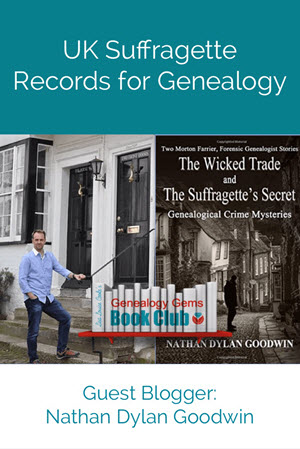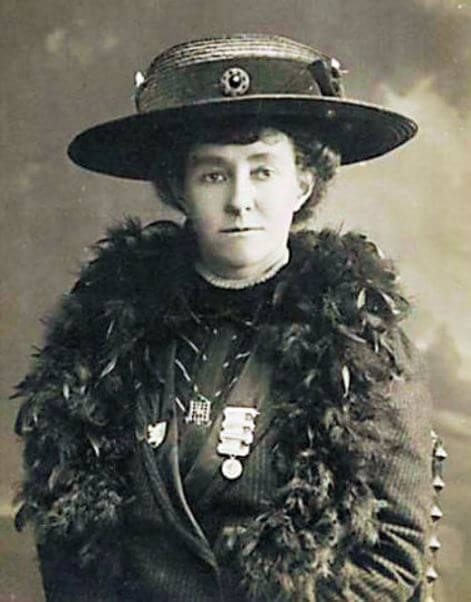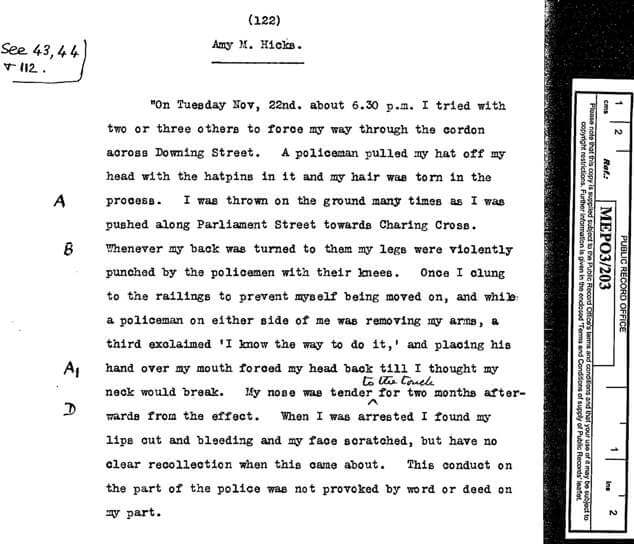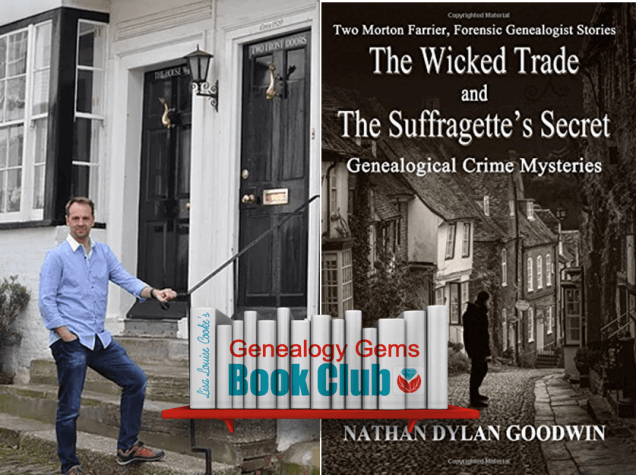These UK Suffragette Records Tell Amazing Stories
UK suffragette records tell amazing stories about the women and men who fought the British government for women’s voting rights a century ago. Nathan Dylan Goodwin, the popular Genealogy Gems Book Club author, shares three of his favorite sources for discovering suffragette stories like the one that unfolds in his new short story, “The Suffragette’s Secret.”
Thanks to Genealogy Gems Book Club author Nathan Dylan Goodwin for contributing this guest blog post.
My new short story, “The Suffragette’s Secret,” features a fictional main character, Grace Emmerson, a suffragette living on the South Coast of England in Brighton. But many of the events and supporting characters described in the story are real. In the story, forensic genealogist Morton Farrier uses real historical documents while working in the modern day to uncover Grace’s suffragette past. Many of these historical records (over 55,000 of them) are now available online in the FindmyPast Suffragette Collection.
Morton and I would recommend spending some time browsing this fascinating collection from a pivotal moment in women’s history. Even if your own ancestors did not make the headlines, they may have been involved at a more local level. And the lives of both women and men in your family may have been affected by suffragette activity, whether or not they are mentioned by name in the records. So it is a collection definitely worth exploring.
UK suffragette records I love
1. Suffragette Amnesty register (HO 45/24665)
With the threat of war and its having become inevitable in August 1914, most of the dominant suffragette organizations, including the Women’s Social and Political Union suspended all militant activity. In response, the British government gave an amnesty to more than one thousand women (and some men) who had been arrested for the cause. Their amnesty records are part of the Findmypast Suffragette Collection and also searchable at Ancestry.com (if your subscription includes UK records).
Alongside the names of those arrested comes the date and court where the charge was originally brought – an excellent starting point for further research.
In “The Suffragette’s Secret,” I referenced the real-life case of Nellie Godfrey. In the Amnesty Register of 1914, her name and references appear thus in the image shown here (the links lead to Google Maps references of the Bow Street magistrate’s court):
Godfrey, Nellie
Bow Street 9/7/09 180.782
Bolton 8/12/1909 186.626
Bow Street 27/11/11 203.651
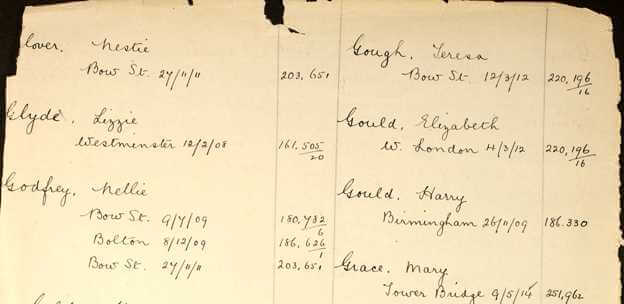
Taking the second reference as an example of where this record can lead, this shows that Nellie appeared on the 8th December 1909 before Bolton Magistrate’s Court.
Searching for these criteria in Findmypast’s Suffragette Newspaper Collection brings up the following story: ‘Nellie Godfrey, of London, was charged at Bolton yesterday with throwing a missile at a motor car in which Mr [Winston] Churchill rode to his meeting on Tuesday night, and was fined 40s or seven days. Defendant went to prison. It was stated that the missile thrown was a piece of iron wrapped in a paper bearing the words “Thrown by a woman of England as a protest against the Government’s treatment of political prisoners.”’
For most of these records, further information exists at the National Archives. Prefixing the reference number with HO (for Home Office) and typing it into the document search box (HO 186626) on the National Archives website brings up a link to a document which details Nellie’s arrest and time in prison. (Unfortunately, these records are not yet digitized, but can be ordered.)
2. Calendar of Prisoners
These records, about suffragette prisoners who were tried in the London courts between 1911 and 1914, feature some of the prominent names from the movement, including the famous Pankhursts (one of whom is shown in the Calendar of Prisoners image below):

One record found in Crim 9/58 is that of Emily Wilding Davison, shown here. She was killed when she threw herself under the king’s horse at Epsom on 8th June 1913. Among several interesting details found in a document pertaining to an earlier arrest in December 1911 are to be found the following facts:
Emily Wilding Davison, 36, a tutor, arrested for ‘unlawfully and maliciously placing in a Post Office letter box a dangerous substance likely to injure the same and its contents and attempt to commit like offence.’ She was jailed at Holloway for six months.
This type of militancy, placing dye or some other kind of corrosive liquid into a letter box in order to render the letters inside illegible, was common among suffragettes and an act often making the local newspapers, which can be read about as part of the Suffragette Collection.
Further records for Emily Wilding Davison exist in the FindmyPast Suffragette Collection, including HO 144/1150/210696, which details several of her actions and subsequent convictions.
3. Suffragettes’ Complaints against Police (MEPO 3/203)
During my research for “The Suffragette’s Secret,” I visited the National Archives and accessed the Suffragette’s Complaints against Police, which was then not available online. At 286 pages, “Complaints against Police” provides an illuminating account of how the police handled a large group of suffragettes who had converged on Downing Street, intent on gaining access to the Prime Minister’s (Herbert Asquith) residence. A sample appears here, to the right.
The file includes several accounts from the perspective of the police involved, in which they all strenuously deny any harsh treatment of the women whom they encountered there. In contradiction to this are the numerous and varied statements from men and women involved in the altercation in which physical abuse and violence by the policemen was described as wide-spread, as this statement from the file attests:
‘About 2.15 in Parliament Square PC A.R.82 struck a Women’s Social & Political Union member in the face. At about 2.30 between Parliament Square and Cannon Row, almost opposite Palace Chambers, PC R.R.21 twisted the arm of and shook furiously a lady he had arrested. She was not resisting arrest. During the raid in Downing Street yesterday evening PC 449B got his knee into the middle of one woman’s back and knocked her down. PC 456E afterwards banged the same woman’s head repeatedly against the railings. I can produce my witness at any inquiry.’
This Suffragette Collection from FindmyPast contains a wealth of information useful to genealogists, social historians and those interested in women’s history. Other records available include cabinet papers, the treatment and force-feeding of political prisoners and various actions and imprisonments of the women men and men involved in the fight to gain the ability to vote.
Nathan Dylan Goodwin is one of our favorite Genealogy Gems Book Club authors! He’s a must-read for anyone who loves a good mystery–especially when the solving is led by a skilled (and very likable) forensic genealogist. Nathan first joined the Genealogy Gems Podcast to talk about his book The Lost Ancestor, but he now has several Morton Farrier, Forensic Genealogist books out. The newest one is a 2-for-1 bonus: “The Suffragette’s Secret,” the short story, is published with his new full-length book, The Wicked Trade. Click on these titles to order them–or check out all his books (and other great titles) on the Genealogy Gems Book Club webpage.
Disclosure: This article contains affiliate links and Genealogy Gems will be compensated if you make a purchase after clicking on these links (at no additional cost to you). Thank you for supporting Genealogy Gems!

